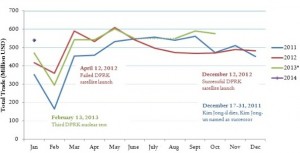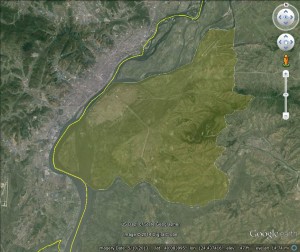Previous reports indicated that the execution of Jang Song-thaek has to date had little effect on DPRK-China trade. According to the Institute for Far Eastern Studies (2014-3-12):
Trade between North Korea and China in January has increased roughly 16 percent against the previous year. After the December 2013 purge of Jang Song Thaek it was predicted that trade between the two countries would decrease; however, there is no visible sign of this yet.
According to the Korean Foreign Trade Association’s* data, trade between North Korea and China in February increased from 471 million USD to 546 million USD, up 15.9 percent compared to the previous year.
February also showed an increase in anthracite exports, North Korea’s main export to China, rising 21.3 percent to 102 million USD. Iron ore exports also showed a slight increase of 35 million USD compared to last year.
Chinese exports to North Korea, including leading export commodities such as cellular phones and other wireless radio/communication devices, increased 28 percent compared to January of last year, totaling 14.5 million USD. In February, goods exported through China to North Korea increased by 10.2 million USD, a 38.6 percent increase compared to January of last year.
The trade gains in this report are annual for the most part…comparing 2013 data with 2014 data. This reveals little about the change in trade volume from month to month.
Now a story in Yonhap offers January and February 2014 data, and journalists have reached the opposite conclusion. Jang’s execution has played a role in DPRK-China trade. According to the article:
“In January and February this year, North Korea significantly stepped up checks on its coal exports to China,” a source in Beijing said on the condition of anonymity.
“Such reinforced checks appear to be related to the execution of Jang Song-thaek,” the source said.
According to the latest data by the Korea International Trade Association* in Seoul, North Korea’s exports of coal to China in February fell 26 percent from a month ago to 920,000 tons. The North’s exports of iron ore to China also fell 23 percent in February from a month earlier to 197,000 tons.
The North’s total trade with China in February plunged 46 percent from a month earlier to US$255 million, the data showed.
In Dandong, the Chinese border city with North Korea where about 80 percent of bilateral trade is conducted, the flow of goods in and out of North Korea appears to be affected by the execution of Jang.
“In previous years, the North Korean authorities had usually set their annual targets for exports and imports, and given quotas to trading firms,” said another source in Dandong who is doing businesses with North Korea. “But, no quota has been given yet this year.
“Obviously, the mood is different than previous years,” the source said.
No progress has been made on special economic zones, including Hwanggumphyong and Wihwa, set up by the North on the border with China, according to the source.
“Under the current circumstances, Chinese investors will not invest in the North’s special economic zones,” the source said.
Does this mean anything? Well, we don’t know enough about these numbers, or the cause for such dramatic change in trade patterns, so we will need to continue to watch the data. Even before the February numbers came out, Scott Snyder reminded us that DPRK-China trade has taken a dip between January and February for each of the last three years!
Then there are the caveats: 1. This only counts legitimate trade (no illicit, secret, or military trade) 2. No aid 3. No official or unofficial transfers 4. No capital flows.
*Presumably the Korean Foreign Trade Association and the Korea International Trade Association are the same thing.
Read the full Yonhap story here:
N. Korea’s trade with China shaken after Jang’s execution
Yonhap
2014-4-4


